MITSUBISHI ECLIPSE 1990 Owner's Guide
Manufacturer: MITSUBISHI, Model Year: 1990, Model line: ECLIPSE, Model: MITSUBISHI ECLIPSE 1990Pages: 391, PDF Size: 15.27 MB
Page 31 of 391
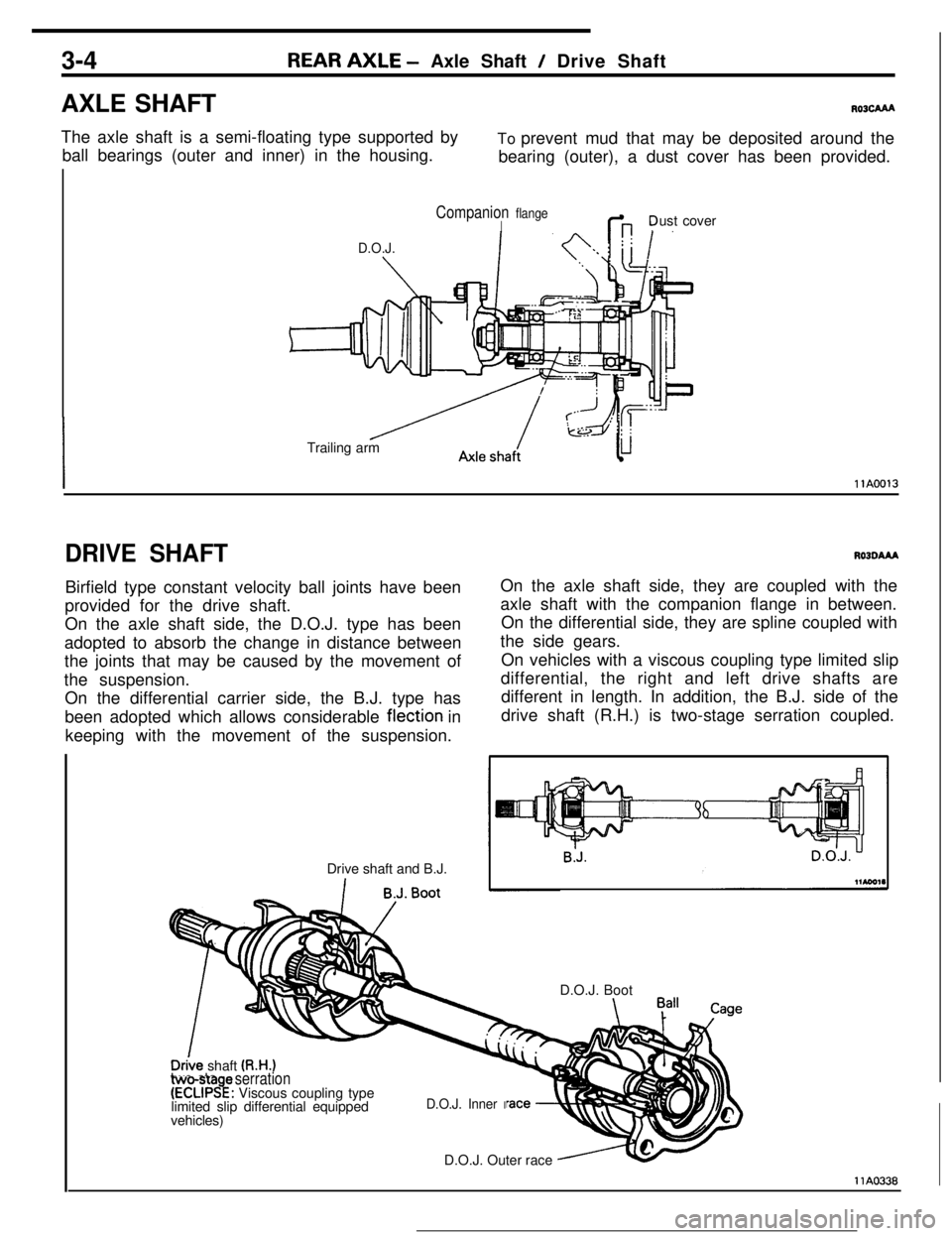
3-4REAR AXLE - Axle Shaft / Drive Shaft
AXLE SHAFT
R03cAAAThe axle shaft is a semi-floating type supported by
ball bearings (outer and inner) in the housing.To prevent mud that may be deposited around the
bearing (outer), a dust cover has been provided.
D.O.J.
Companion flangeIG ?ust cover
Trailing arm
IllA0013
DRIVE SHAFTBirfield type constant velocity ball joints have been
provided for the drive shaft.
On the axle shaft side, the D.O.J. type has been
adopted to absorb the change in distance between
the joints that may be caused by the movement of
the suspension.
On the differential carrier side, the B.J. type has
been adopted which allows considerable flection in
keeping with the movement of the suspension.
Drive shaft and B.J.RO3OAAAOn the axle shaft side, they are coupled with the
axle shaft with the companion flange in between.
On the differential side, they are spline coupled with
the side gears.
On vehicles with a viscous coupling type limited slip
differential, the right and left drive shafts are
different in length. In addition, the B.J. side of the
drive shaft (R.H.) is two-stage serration coupled.
D.O.J. Boot
_vehicles)
D.O.J. Outer race
D&e shaft (R.H.)two-sta e serration(ECLIPS!: Viscous coupling type
limited slip differential equipped
D.O.J. Inner I
llA0338
Page 32 of 391

REAR AXLE- Viscous Coupling Type Limited Slip Differential3-a
DIFFERENTIALROlEAM
The differential uses lower torque bearings and
lower torque oil seals to improve power perform-
ante and fuel consumption.
For faster differential cooling and higher reliability
during high speed operation, a differential carrier
with cooling fins has been adopted.For better serviceability, spacers for adjustment of
final drive gear backlash have been inserted
be-tween the side bearing outer race and gear carrier.
A speed difference responsive type viscous
cou-
pling type limited slip differential which provides
outstandingperformance during operationon a
Side gearPinion gearDifferential coverQ./\Side bearing spaceifferential case
VISCOUS COUPLING TYPE LIMITED SLIP DIFFERENTIALRWEBAAWhile the conventional mechanical type limited slip
differential uses a cam (differential pinion shaft) and
disc equipment
compo.sed of a friction plate, disc
and spring seat in limiting the differential, theviscous coupling type limited slip differential limits
the differential by use of a viscous coupling equip-
ment consisting of outer and inner plates and
silicone oil.
Front wheel
Center differential
’ (viscous coupling)Rear wheel
Limited slip differential
assembly
Front differential, I
TDifferential
Differential limiting section
(viscous coupling)11KmI66
L.-
Page 33 of 391
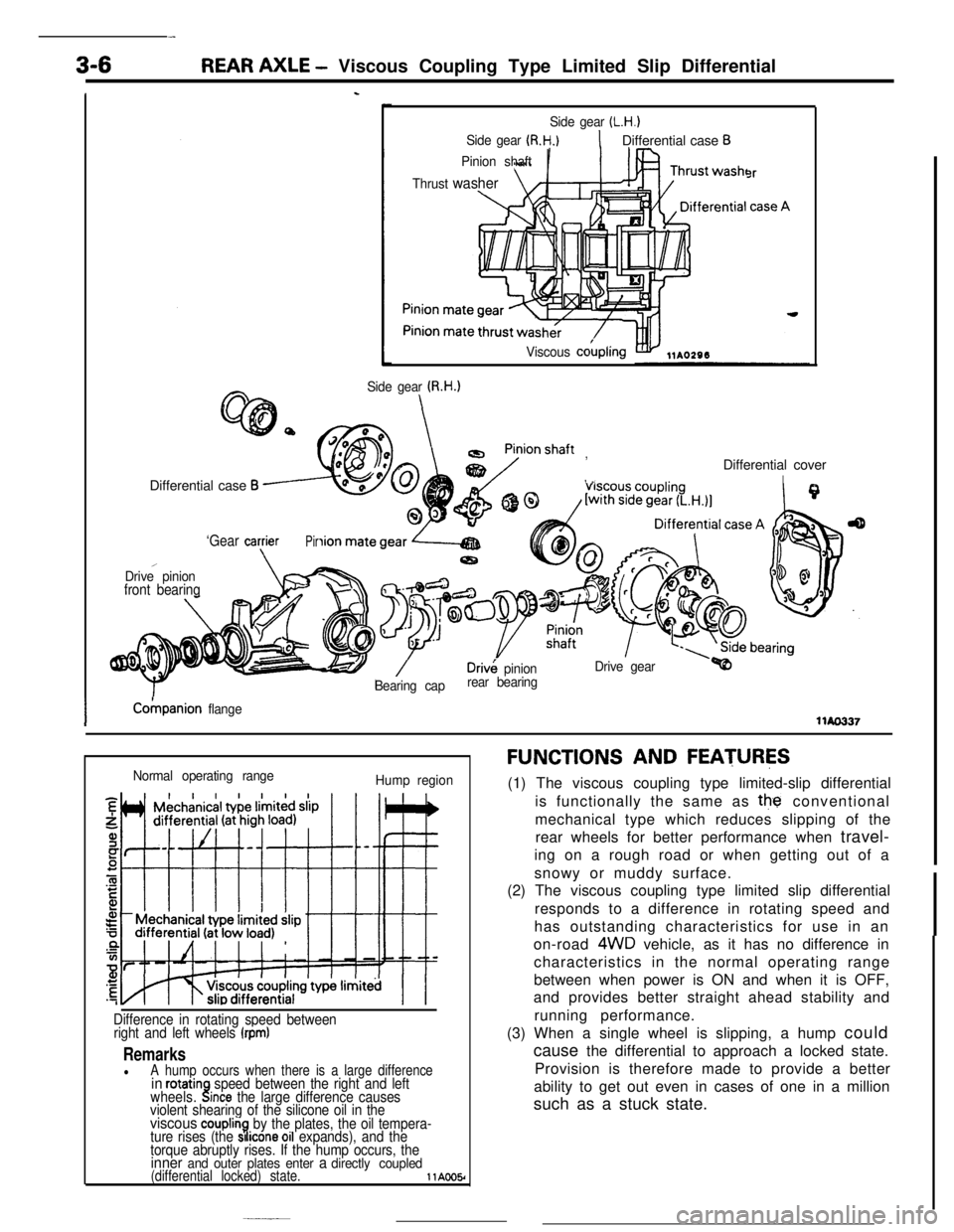
3-6REAR AXLE - Viscous Coupling Type Limited Slip Differential
Is
Side gear (L.H.)
Side gear (R.H.)1Differential case B
Pinion shaft
Thrust
washer
Viscous cokpling
3r
Side gear U3.H.)Differential case
B
, ,,Differential cover
I
‘Gear cagierPir
,Drive pinionfront bearing
Driv& pinionDrive gear
Bearing caprear bearing
ICokpanion flangellAo337
Normal operating range
Hump region
Difference in rotating speed between
right and left wheels (rpm)
RemarkslA hump occurs when there is a large differencein rotatinwheels..!speed between the right and leftlnce the large difference causes
violent shearing of the silicone oil in the
viscous couplin7.by the plates, the oil tempera-
ture rises (the SI Icone 011 expands), and the
torque abruptly rises. If the hump occurs, the
inner and outer plates enter a directly coupled(differential locked) state.llAOO5r
FUNCTIONS AND FEATURES(1) The viscous coupling type limited-slip differential
is functionally the same as
the conventional
mechanical type which reduces slipping of the
rear wheels for better performance when travel-
ing on a rough road or when getting out of a
snowy or muddy surface.
(2) The viscous coupling type limited slip differential
responds to a difference in rotating speed and
has outstanding characteristics for use in an
on-road
4WD vehicle, as it has no difference in
characteristics in the normal operating range
between when power is ON and when it is OFF,
and provides better straight ahead stability and
running performance.
(3) When a single wheel is slipping, a hump could
cause the differential to approach a locked state.
Provision is therefore made to provide a better
ability to get out even in cases of one in a million
such as a stuck state.
Page 34 of 391
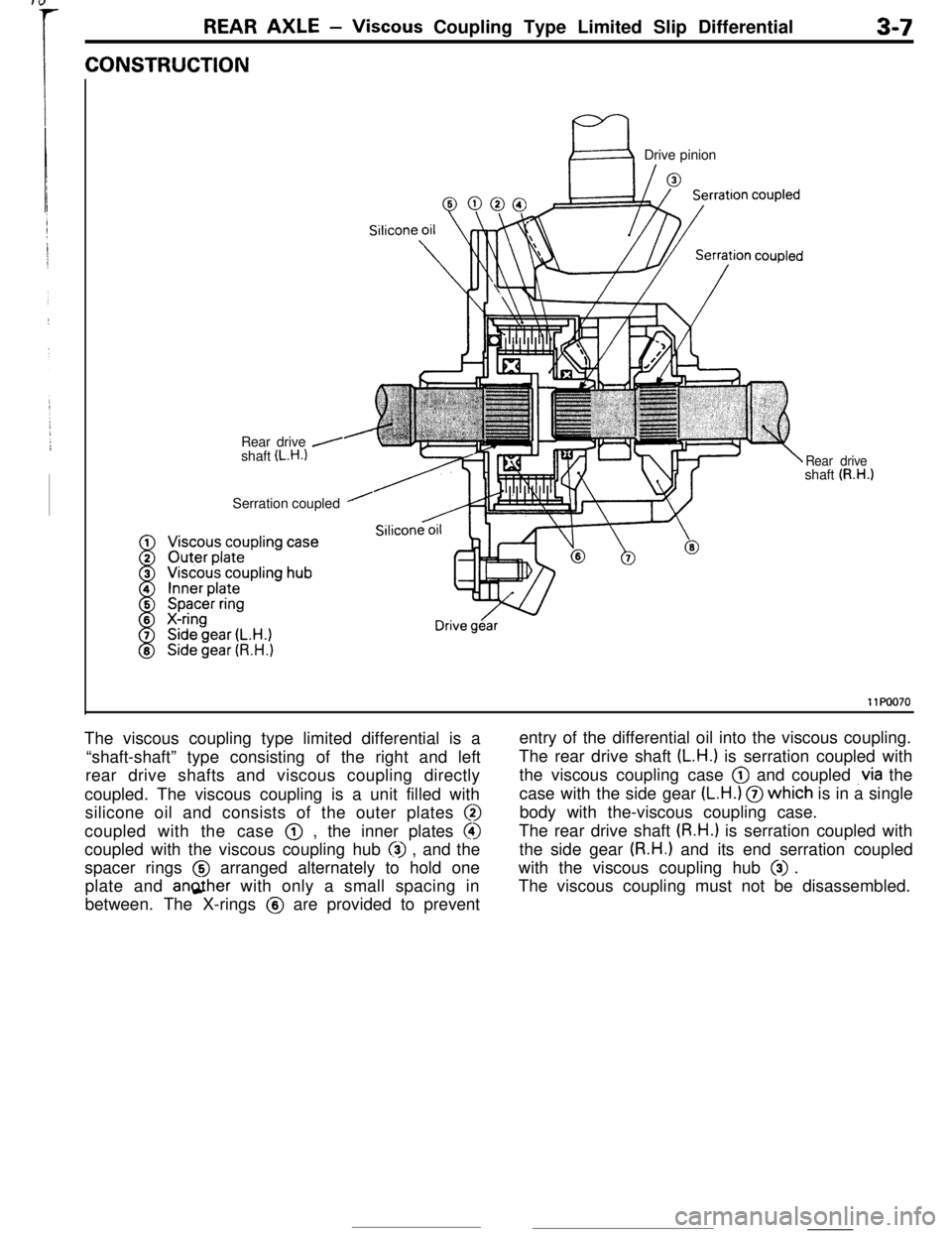
REAR AXLE -Viscous Coupling Type Limited Slip Differential3-7CONSTRUCTION
Rear drive
/shaft (L.H.)Serration coupled
ElDrive pinion
Rear driveshaft (R.H.1
11Po070The viscous coupling type limited differential is a
“shaft-shaft” type consisting of the right and left
rear drive shafts and viscous coupling directly
coupled. The viscous coupling is a unit filled with
silicone oil and consists of the outer plates @
coupled with the case @ , the inner plates @
coupled with the viscous coupling hub
(j) , and the
spacer rings @ arranged alternately to hold one
plate and angther with only a small spacing in
between. The X-rings @ are provided to prevententry of the differential oil into the viscous coupling.
The rear drive shaft
(L.H.) is serration coupled with
the viscous coupling case @ and coupled
,via the
case with the side gear
(L.H.) @which is in a single
body with the-viscous coupling case.
The rear drive shaft
(R.H.) is serration coupled with
the side gear
(R.H.) and its end serration coupled
with the viscous coupling hub
0) .
The viscous coupling must not be disassembled.
Page 35 of 391
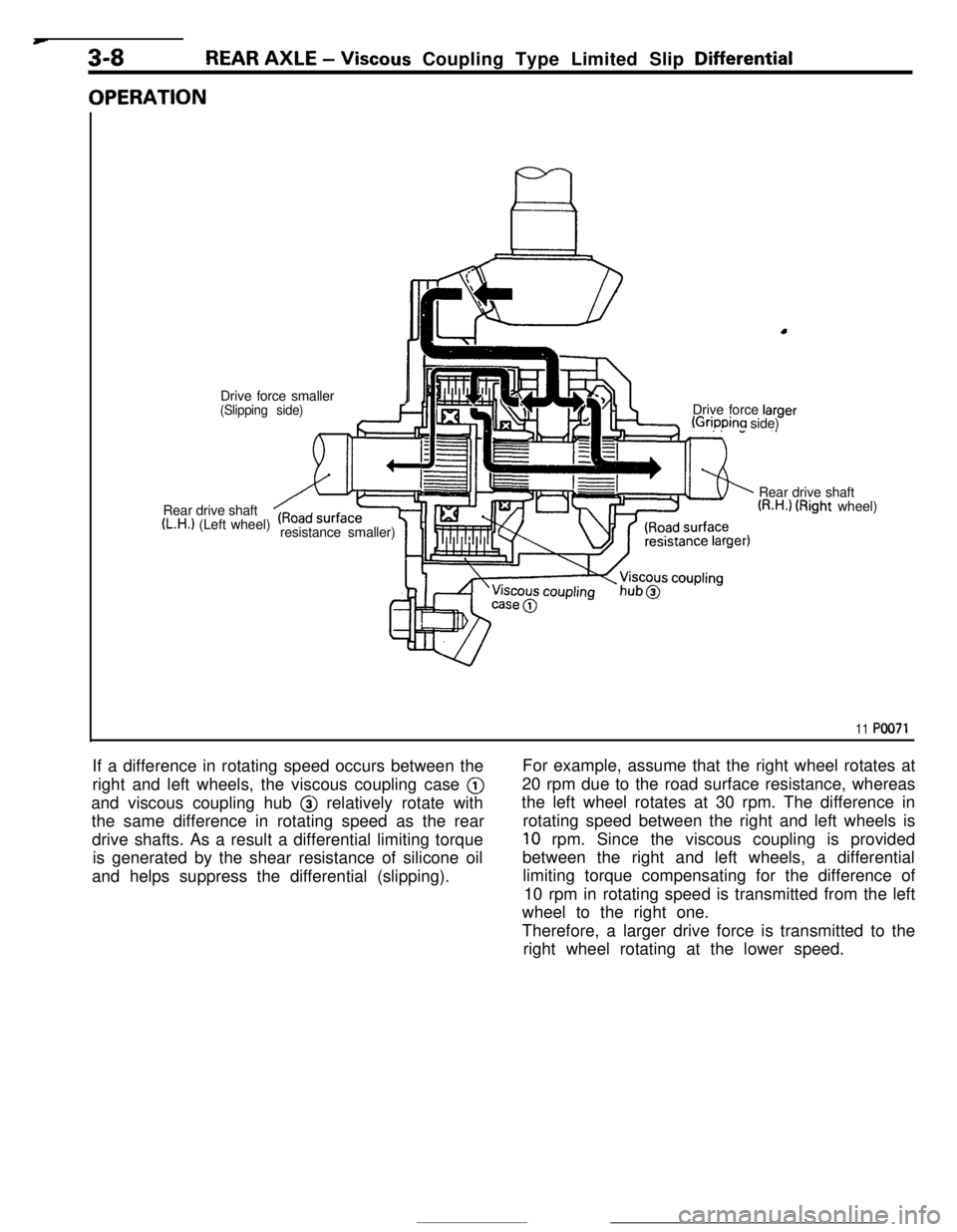
w
3-8REAR AXLE - Viscous Coupling Type Limited Slip Differential
OPERATIONDrive force smaller
I(Slipping side)Drive force larger(Grippina side)
Rear drive shaft
(L.H.1 (Left wheel)
resistance smaller)Rear drive shaft
(R.H.1 (Right wheel)
11 PO071If a difference in rotating speed occurs between the
right and left wheels, the viscous coupling case @
and viscous coupling hub @ relatively rotate with
the same difference in rotating speed as the rear
drive shafts. As a result a differential limiting torque
is generated by the shear resistance of silicone oil
and helps suppress the differential (slipping).For example, assume that the right wheel rotates at
20 rpm due to the road surface resistance, whereas
the left wheel rotates at 30 rpm. The difference in
rotating speed between the right and left wheels is
10 rpm. Since the viscous coupling is provided
between the right and left wheels, a differential
limiting torque compensating for the difference of
10 rpm in rotating speed is transmitted from the left
wheel to the right one.
Therefore, a larger drive force is transmitted to the
right wheel rotating at the lower speed.
Page 36 of 391
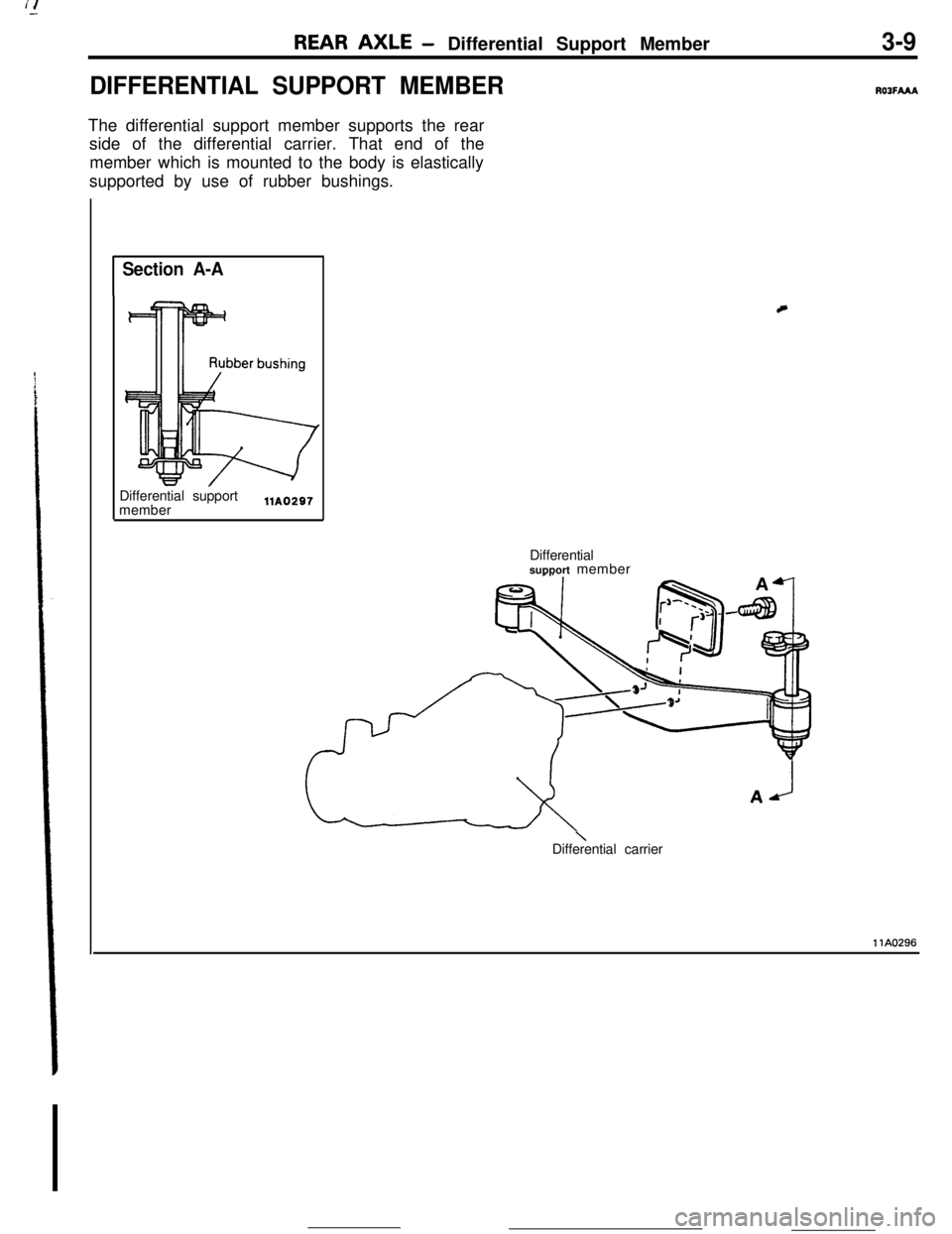
REAR AXLE- Differential Support Member3-9
DIFFERENTIAL SUPPORT MEMBER
ROJFAAAThe differential support member supports the rear
side of the differential carrier. That end of the
member which is mounted to the body is elastically
supported by use of rubber bushings.
Section A-ADifferential support
member
llA0297
cDifferential
support member
\Differential carrier
Page 37 of 391
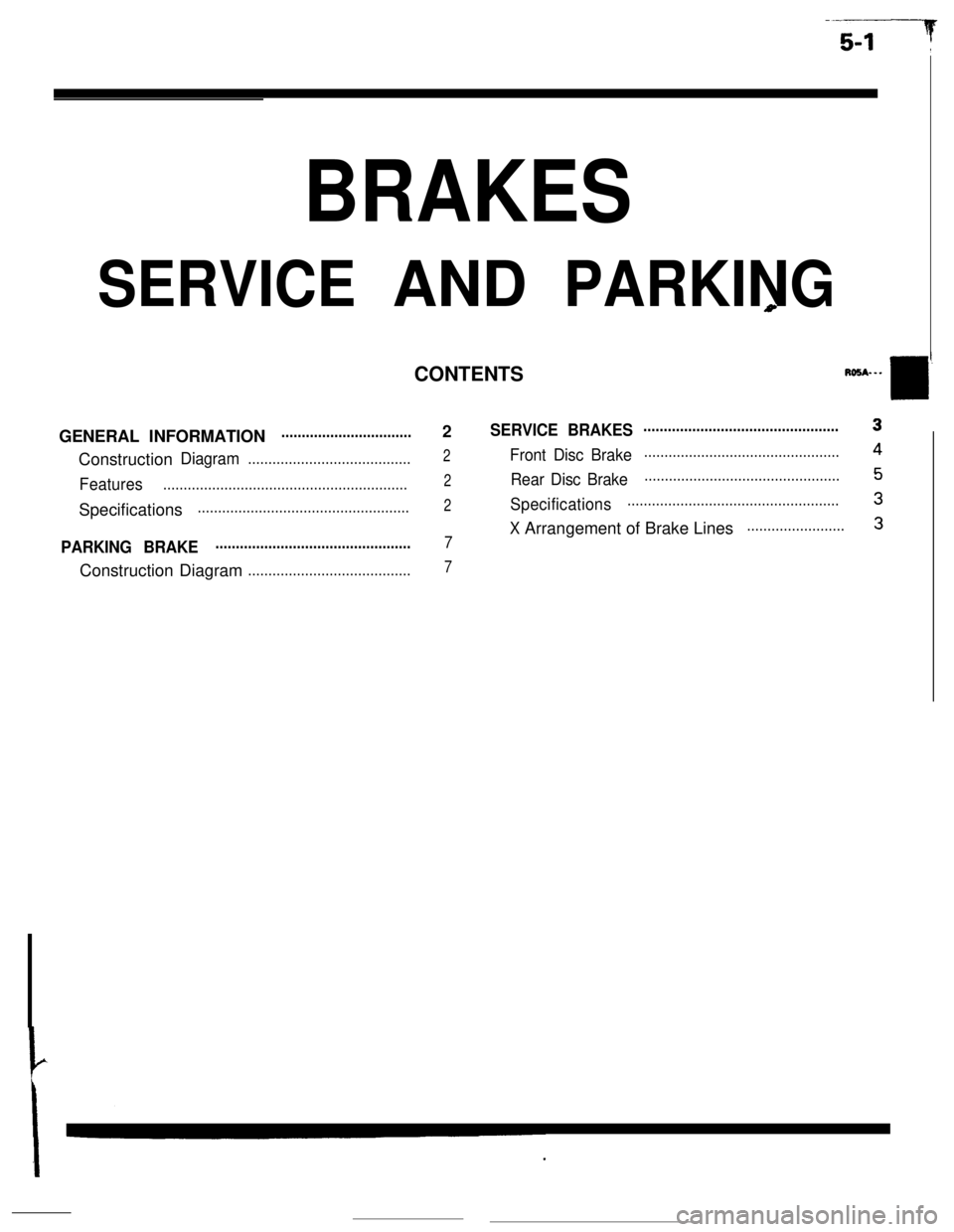
BRAKES
CONTENTS
Page 38 of 391
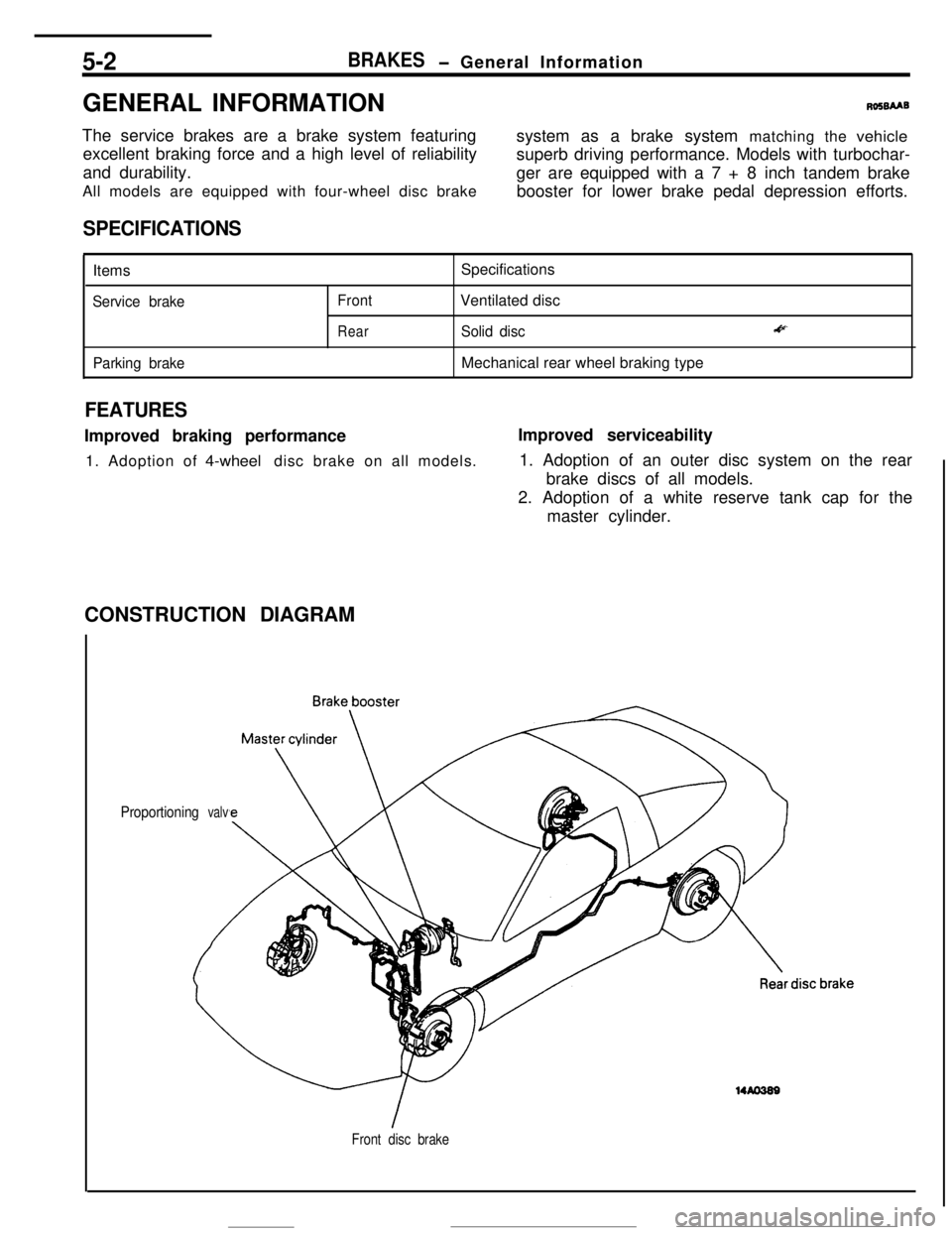
5-2
FEATURES
Page 39 of 391
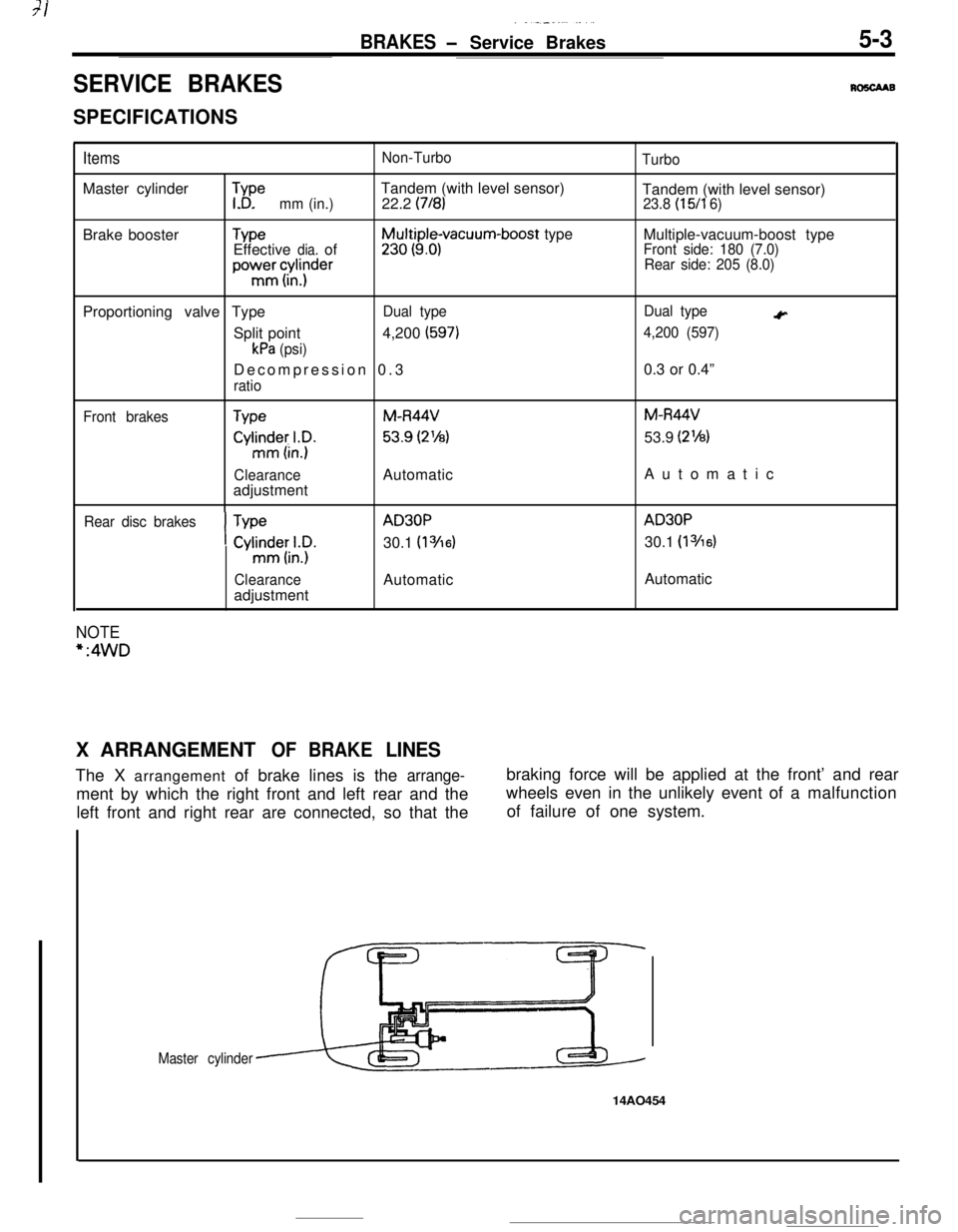
BRAKES - Service Brakes 5-3
$eTandem (with level sensor)
(718)
Brake boosterTYpeEffective dia. of
y3tt$;ivacuum-boost type
powmermc&;der
Proportioning valve Type Dual type
(597)
kPa (psi)
Decompression 0. 3
(15/l 6)
Multiple-vacuum-boost type
c
4,200 (597)
TypeM-R44VM-R44V
cyhnxLy.53.9 (2’/8) 53.9 (2%)
Clearance Automatic Automati
c
I
TypeAD30PAD30P
Cyl~itl;.~. 30.1 (13/16) 30.1 (13/16)
Clearance Automatic Automatic
*:4WD
X
ARRANGEMENT OF BRAKE LINES
Page 40 of 391
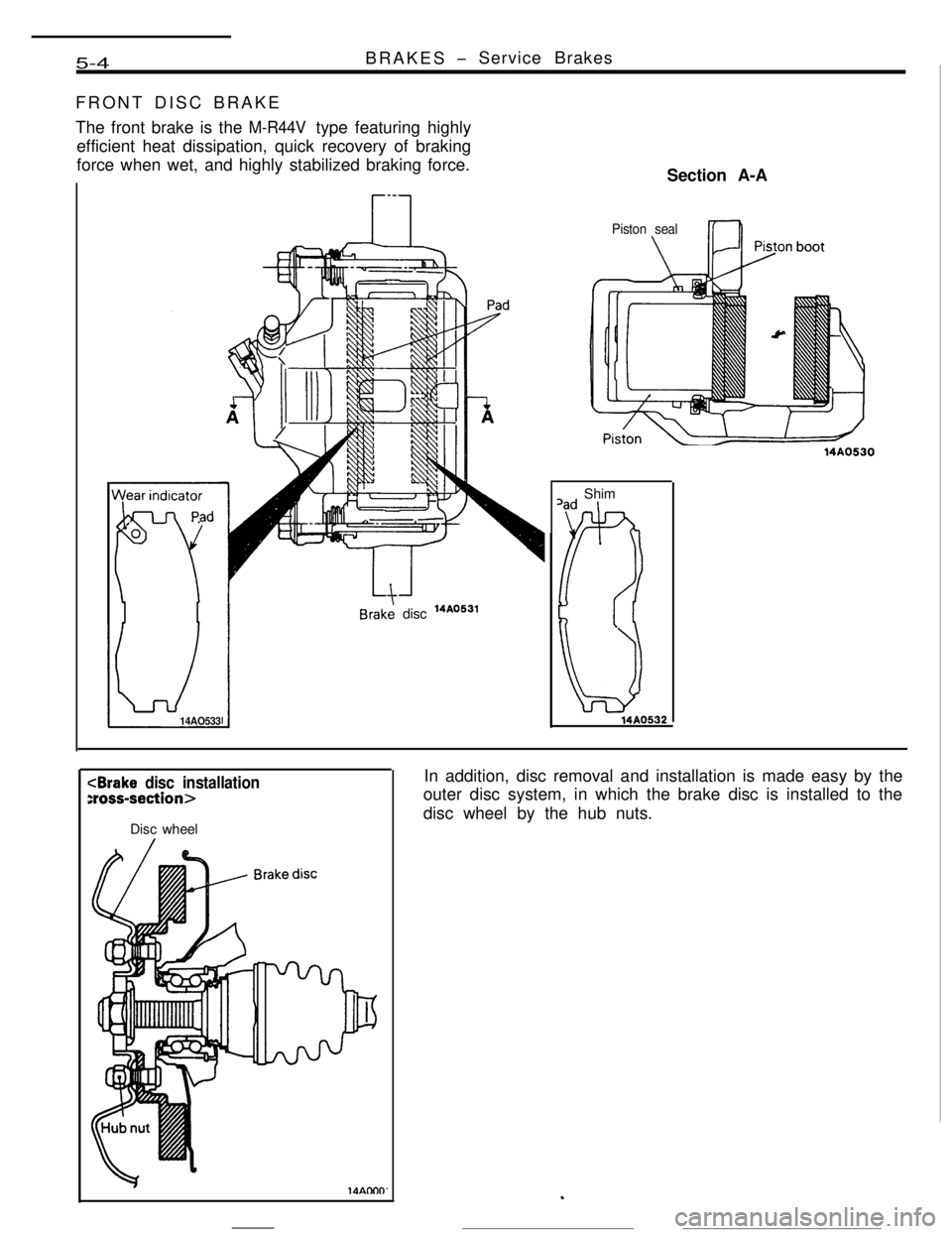
5-4
Braki disc 14A0531
Section A-A
14AO530
,ad Shim
014A0532
Disc wheel
.